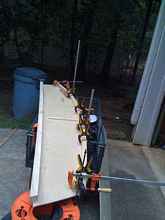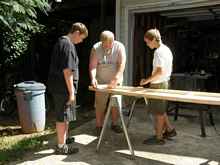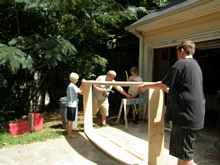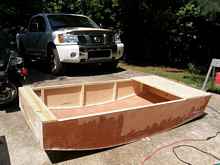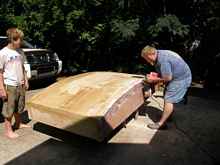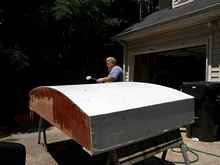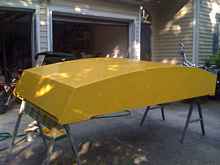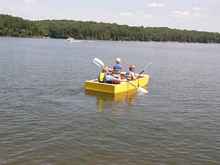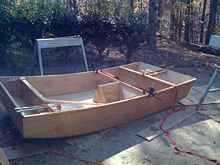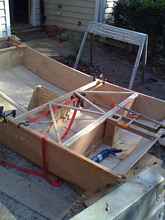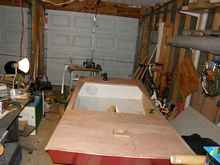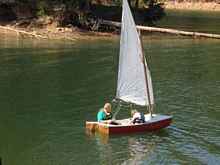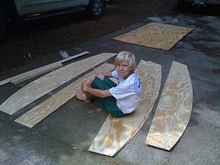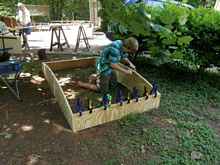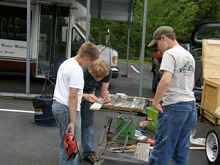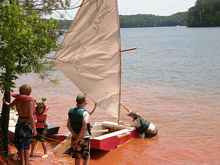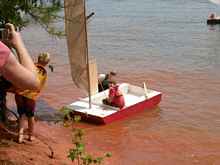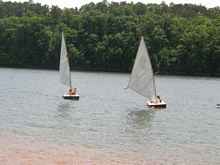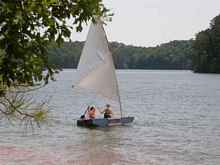
| sails |
| plans |
| epoxy |
| rope/line |
| hardware |
| canoe/Kayak |
| sailmaking |
| materials |
| models |
| media |
| tools |
| gear |
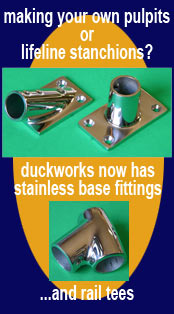 |
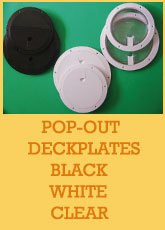 |
| join |
| home |
| indexes |
| classifieds |
| calendar |
| archives |
| about |
| links |
| Join Duckworks Get free newsletter Comment on articles CLICK HERE |
|
|
| Guest Column |
by David Chamness - Holly Springs, Georgia - USA How I Ended up with a Yard Full of Ducks |
| I have always had a love of boats, and of the water. In high school, in the early '80s, a good friend and I watched hydroplane boats race around Lake Charles, Louisiana and decided that we should build one of our own. The boat was ten and a half feet long, just under five feet wide, and had a tunnel hull. Most of the talent was his, I provided the garage, half the money, and just did what he told me to do. We put a 25 hp Johnson outboard on it and used it to race up and down the bayou.
Fast forward twenty five years and I was living in Georgia, just a few miles from Lake Allatoona. I'd been reading through several websites on boat building on the Internet, looking for a boat design I could build.
I'd already tried once, buying plans for a Stevenson Weekender, but didn't get very far along before giving up. I decided my woodworking skills just weren't up to the task.
I had seen the PDRacer site, and read the description of the little boats with interest, but not with any intention of building one. They were such funny little boats! I wanted something larger, something more nautical.
Then I read the story of the Texas 200 race, and the dramatic rescue of a boat by several PDRacer captains. On the same site where I read the account, I saw that the World Championship Race was going to be held right in my back yard, at Lake Allatoona. I lived less than 6 miles from the launch ramp, for goodness sake! Right then and there I told my wife that I had to build one, and be part of that group of people.
My first PDRacer, Whack Whack (hull #336), was way overbuilt. I used quarter inch ply for the sides, but a solid board for the bow and stern, and 2X2s for chine logs. I got it finished just in time for the race, but didn't have the bugs worked out, so I had several failures on raceday, so I sailed that day, but could not have been said to actually participate in the race.
What amazed me was the kindness and encouragement of everyone who was there. Here I was with a very poorly constructed, barely working example of the class, while their boats were floating pieces of art, and they included me in their ranks as if my pitiful effort was every bit their equal. I went home determined to build again, and this time do a proper job of it.
After the races I started working on a new design. This one was to be lighter, using 3/4" chine longs and ply for the bow and stern transoms, and featured a daggerboard in the center of the boat rather than a leeboard. The reason for the design of the new one is that I'm not all that terribly creative, and Shawn Payment's was so impressive in his boat Yowza, that I copied the look.
My new boat (#388) was half the weight of my first effort, and performed much better. I finished it over the winter and sailed it on the lake several times before the 2010 PDRacer Regionals, held at Red Top Mountain. Not being an experienced sailor, I was soundly beaten by nearly everyone, but I loved it nonetheless.
I used the front/rear airbox design on my second hull, which was a big improvement over my first design, which was a completely open boat. It had a deck across the front, but it was open underneath. I had read that capsize tests might be required for the boats, and I was pretty sure that my first boat would not be able to be sailed after a capsize.
On a warm day, I think in early March, I met Scott Widmier and Steve Gully at South Winds Sailing Club for a duck sail. The winds were a bit higher than we expected (there were white caps!) and we seriously considered rescheduling for another day. Since were there, and I already had my boat in the water, we decided to go ahead and sail.
I struggle to get out of the cove, since the wind was coming directly from the harbor opening, but I kept trying. The issue seemed to be that I had a bit too much weather helm, and when the gusts hit, it would turn me into the wind regardless of what I did with the rudder. Both Steve and I broke our tillers fighting the wind. I made a quick repair on mine, Steve decided that he'd had enough and got out his inflatable instead.
After a bit of adjustment of my Balance Lug (moving it forward a bit), I got rid of the excess weather helm and was able to make way upwind. We sailed around a bit in the high winds, but since Scott and Steve had been out for a good bit longer, fairly quickly they decided to head in for lunch. I sailed along for another 10 minutes or so, fairly flying along and getting soaked from the spray.
I decided that I'd join them in the harbor, and turned downwind. That's when the problems started. I had never sailed a Puddle Duck downwind in high winds, and didn't realize how quickly they get overpowered. A decent sized gust hit and pushed me right over. I clearly wasn't sitting far enough back, and wasn't a good enough sailor to handle the sails in high wind, resulting in a capsize.
Since I had fore and aft airboxes, the Duck didn't sink, and I was able to swim around to the bottom and pull her upright with great ease, but she came up with a lot of water in her. Instead of climbing in and trying to sail, I had Steve Gully pull me to the dock with his inflatable.
After that I changed my design to include 8 inch wide decks, so that they will keep water out of the boat in the case of a capsize. I've tested this several times, and it works very well. Even though the boat is open under the decks, they float the Duck high enough that one can right the boat with no extra water inside.
One of the things I like about the PDRacer is the experimental aspect of the boats. While there are several very good, professionally crafted sets of plans, it's perfectly acceptable to go out there and design your own. So long as the hull ends up the same shape as other ducks, it doesn't matter how you build it. And only the lower 10" needs to be constrained to be considered a Duck for racing purposes. At the 10.1" mark and above, anything goes.
You can have a daggerboard, off-center board, lee boards, any vertical foil you want. You can use any sail configuration you want, also. I've used everything from a simple sprit sail, to a Balanced Lug to Leg-o-mutton. They all work well.
After building two ducks, and seeing just how easy it is to achieve a working boat, I decided to try to sell the idea of building a sailboat to my boys' Scout Troop. It took a bit of convincing before the committee would believe that we could do it, but just as they decided that it was something that we might be able to pull off, we were contacted by our local Sea Scout leader. He'd made a deal with some suppliers to pre-cut some plywood and stringers to make kits, if we were interested in building puddle ducks.
We ended up building three ducks in the troop (#501, #544, #545), with the boys doing nearly all the work. Of course, being handy guys most of the fathers involved could not help but to lend a hand here or there, but the majority of the work was the boys'. The design we used for they Troop boats was full length side airboxes, a small front deck, and Bolger LOM sails made from Tyvek. We used bamboo for masts and yards, and carved foils from 1x4 pine. With the busy schedule that the boys have, we weren't able to work on them for more than a few weekend days, and the build stretched out much longer than we expected. It took nearly an entire year to get them completed, but we were finally able to take them all down to the lake for a day of sailing. We've only had them out as a Troop a couple of times, but we plan to take them out again this spring. It's been a wonderful experience, watching the boys build their own boats, and quite a feather in their caps as they grow up that they were able to do this. We hope to challenge the Sea Scouts in the area to a series of races in the near future, with our ducks against theirs.
|
